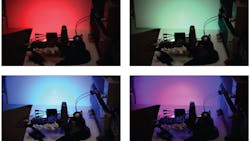How to Control Color of LED Stage and Architectural Lighting (.PDF Download)
This article is part of the Power Management Series: Driving LED Designs
Red, green, and blue (RGB) LEDs can be used in architectural and stage lighting systems to create brightly projected colors—with a white (RGBW) LED sometimes added to the RGB mix to extend the color range in hue, saturation, and brightness. Regardless of the number of color components, the brightness of each component color must be accurately controlled to achieve predictable colors or compensate for color discrepancies amongst LEDs.
The number of available colors depends on the number of resolvable brightness levels of each component color. A few systems offer resolution down to 1/256 (8-bit) of full brightness. Higher resolution is possible and yields more colors and control.
